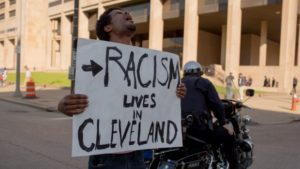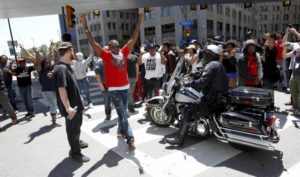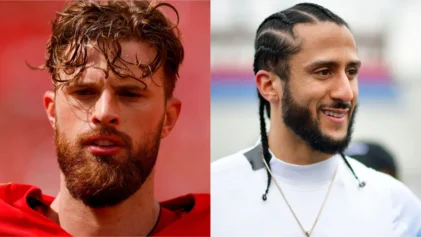
The majority of protesters that demonstrated after Brelo was found not guilty for firing 15 shots into the windshield of Timothy Russell and Malissa Williams following a high-speed chase were mostly peaceful.
According to a timeline of events by the Associated Press, the first wave of protests remained peaceful although the numbers were considerably smaller than the second wave that hit the streets later in the day after 2 p.m.
This is when public disturbances led to the arrest of more than 70 people, although it’s fair to note that officers seemed to show more restraint when it came to making arrests than other departments in cities like Ferguson and Baltimore.
When protesters were blocking traffic on a busy highway, police officers simply followed on foot and in patrol cars in order to block off traffic and allow the protesters to pass. They made no attempt to actually stop the group or force them away from the highway, according to the Associated Press.
When the group began blocking the highway, law enforcement, as they have done in the past, redirected traffic but initially did not arrest the group of demonstrators.
When Cleveland Police Chief Calvin Williams was faced with criticisms regarding the protests that blocked traffic for quite some time, he urged the community to remember that the demonstration was a part of the protesters First Amendment Rights so long as they did not turn violent.

Protestors gather in a downtown intersection as a Cleveland Police officers block them from an RTA bus following the not guilty verdict for Cleveland police officer Michael Brelo on manslaughter charges in Cleveland, Ohio, May 23, 2015. REUTERS/Aaron Josefczyk
But as the day of protests continued, a few outliers became disruptive, according to police, and were taken into custody.
Reports indicated that some people among the crowds began pepper spraying bystanders, including sports fans who were recording the crowd as they walked by. Other small instances of fights were also reported but no reports of widespread violence or vandalism have surfaced as of yet.
Despite a day that involved hundreds of protesters, about 71 were arrested but officials in the city remained adamant in their insistence that the vast majority of protesters were peaceful and had every right to make their voices heard.
It’s certainly a calm scene when compared to the aftermath from other key decisions made that dealt with the deaths of unarmed Black citizens.
But the tensions in the city still have potential to grow worse.
The Cleveland Police Department, which has already been slammed by the Department of Justice for incompetence and unnecessary shooting of suspects, particularly Black suspects, still has two more major decisions looming over the horizon.
“The deaths of 12-year-old Tamir Rice and 37-year-old Tanisha Anderson occurred just eight days apart last November,” the Associated Press reported. “An investigation by the Cuyahoga County sheriff’s department into Tamir’s death is nearly finished and ready to be given to county prosecutors to decide whether to pursue criminal charges against the patrolman.”
As for Anderson’s case, the progress is unclear. Anderson was the mentally ill Black woman that died after police slammed her to the ground and handcuffed her.

Reports revealed 71 Cleveland protesters were arrested although the majority of demonstrations remained peaceful
A medical examiner ruled her death a homicide after revealing she died of positional asphyxiation. In other words, she was unable to breathe properly due to the way officers positioned her on the ground.
As the city of Cleveland continues to attempt to navigate their apparent issues with law enforcement and figure out how to approach the dire need for reform, it’s very likely that the lack of an indictment against officer Timothy Loehmann, the officer who fatally show Rice and failed to provide any first aid as he lie on the ground bleeding to death, could be the match that sets the city ablaze.
The attorney for the Rice family made it clear that they are pushing for an independent prosecutor although it isn’t clear if there has been any progress made on finally getting a decision on that request.
Meanwhile, the case surrounding Russell and Williams isn’t over just yet.
Five police supervisors have been charged with misdemeanor dereliction of duty for failing to control the chase and Brelo is still facing administrative charges related to the case. He is currently still suspended without pay.
The Department of Justice also announced that they will be reviewing all evidence available in the Brelo case to determine if any federal action needs to be taken.


